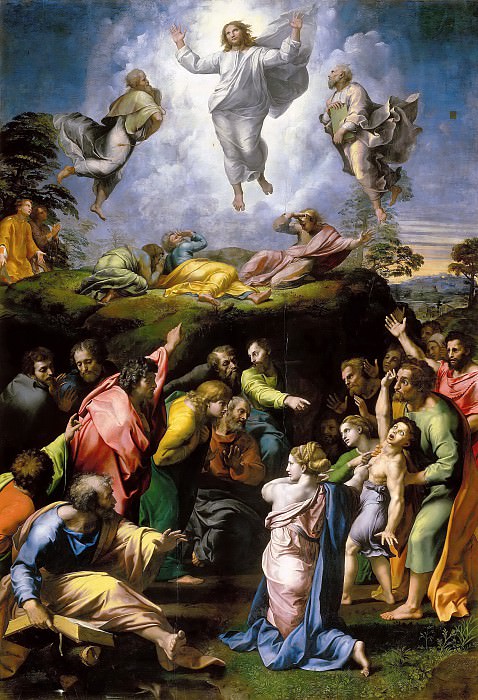拉斐尔 (Raffaello Santi, Raffaello Sanzio da Urbino)
(1483-1520)

Raphael Santi - Variant of the Lord 1516-20 405x278
All of Raphael's paintings are a vivid reflection of his subtle nature. From an early age, he was endowed with tenacious diligence and a desire for spirituality and purity. Thus, in his works he tirelessly conveys fascinating forms of sublime thought. Perhaps this is why such a large number of works were born under the pen of the master, which conveyed the perfection of the world around them and its ideals. Probably no Renaissance artist could have brought their paintings to life so cleverly and profoundly. At least recall the real artistic masterpiece of the time, the "Sistine Madonna".
Raphael Santi - Sistine Virgin 1512-14 265x196
Rafael Santi - Donna Velata (Veiled Lady) 1516. 85x64
Raphael Santi - St. George with Dragon 1503-05 29x25
Raphael Santi - Oddi Altarpiece - Enter the Sanctuary (predella) 1502-04 27x50
Raphael Santi-Madonna di Frigno 1511-12. 320x194
Raphael Santi-Madonna and the child with John the Baptist in the Landscape (Beautiful Gardener) 1507, 122x80
Raphael Santi - Holy Family with Palm Tree c.1506. 102cm
Raphael Santi - Conestabile Madonna 1504. 17.5x18
Raphael Santi – The Holy Family of Oak Trees 1518, 144x110
Raphael Santi - Hall of Constantine: Ceiling painting 1517-24
The Italian High Renaissance brought great artists to the world: Leonardo da Vinci, Michelangelo, Raphael, Titian. Each of them embodied the spirit and ideals of that era in his work. The purposefulness of cognition is vividly embodied in Leonardo's work, in Michelangelo's work - the tragedy and drama of striving for perfection, in Titian - a happy free mind, Raphael sings of beauty and harmony.
Raphael (more precisely Raphael Santi) was born on April 6, 1483 (according to other sources, March 28, 1483) to the family of Giovanni Santi, a court painter and poet of the Duke of Urbino in the city of Urbino. Raphael's father was an educated man who instilled in his son a love of art. Raphael received his first painting lesson from his father.
Raphael died when he was 8 years old, and when he was 11, after his father died, he became an orphan.
In the middle of the 15th century, the city of Urbino, where Raphael was born and raised, was a splendid center of art, a center of Italian human culture. The young artist met wonderful works of art in the churches and palaces of Urbino, and the beneficial atmosphere of beauty and art awakened imagination, dreams and cultivated artistic taste. Biographers and researchers of Raphael's work believe that over the next 5-6 years he studied painting with the mediocre Urbino masters Evangelista di Piandimeleto and Timoteo Viti.
In 1500, Raphael Santi moved to Perugia to continue his education in the studio of the greatest Umbrian painter, Pietro Perugino (Vanucci). Perugino's artistic style, contemplative and lyrical, is very close. Raphael, aged 17-19, created his first works of art, The Three Beauties, The Knight's Dream, and the famous Singing Virgin. Madonna's theme is particularly close to Raphael's lyrical flair, and it is no coincidence that she will continue to be one of the main figures in his work.
Raphael's Virgins are usually depicted in a landscape background, and their faces exude calm and love.
During the Perugin period, the painter created the first monumental work for the church, "Mary's Engagement", marking a new stage in his work. In 1504, Raphael moved to Florence. He lived in Florence for four years, occasionally traveling to Urbino, Perugia and Bologna. In Florence, the artist joined the artistic ideals of the Renaissance and became acquainted with ancient works. Meanwhile, Leonardo da Vinci and Michelangelo worked in Florence, making cardboard for battle scenes in the Palazzo Vecchio.
Raphael studied ancient art, creating sketches based on the works of Donatello, Leonardo and Michelangelo. He drew a lot of inspiration from life, depicted nude models, and achieved the correct transfer of body structure, movement, and plasticity. At the same time, he studied the laws of monument composition.
Raphael's style of painting was changing: it found a stronger expression of plastic, form – more generalization, composition – simpler, more rigorous. During this period, the image of Madonna became the main image. The fragile, dreamy Virgins of Umbria have been replaced by images of more secular bloodlines, and their inner worlds have become more complex and emotionally rich.
Raphael's paintings reflect the style, aesthetics and worldview of that era, the Renaissance. Raphael was born to express the ideals of the Renaissance, the dream of a beautiful man and a beautiful world.
Raphael died on April 6, 1520, at the age of 37. This great artist was buried in the Pantheon. For centuries, Raphael has been the pride of Italy and all mankind.